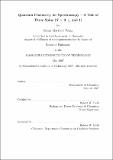| dc.contributor.advisor | Robert W. Field. | en_US |
| dc.contributor.author | Wong, Bryan Matthew, 1979- | en_US |
| dc.contributor.other | Massachusetts Institute of Technology. Dept. of Chemistry. | en_US |
| dc.date.accessioned | 2007-12-07T15:25:50Z | |
| dc.date.available | 2007-12-07T15:25:50Z | |
| dc.date.copyright | 2007 | en_US |
| dc.date.issued | 2007 | en_US |
| dc.identifier.uri | http://hdl.handle.net/1721.1/39671 | |
| dc.description | Thesis (Ph. D.)--Massachusetts Institute of Technology, Dept. of Chemistry, 2007. | en_US |
| dc.description | This electronic version was submitted by the student author. The certified thesis is available in the Institute Archives and Special Collections. | en_US |
| dc.description | Vita. | en_US |
| dc.description | Includes bibliographical references (p. 193-203). | en_US |
| dc.description.abstract | Three special topics in the field of molecular spectroscopy are investigated using a variety of computational techniques. First, large-amplitude vibrational motions on ground-state singlet (S0) potential energy surfaces are analyzed for both the acetylene/vinylidene and the HCN/HNC isomerization systems. Electronic properties such as electric dipole moments and nuclear quadrupole coupling constants are used as diagnostic markers of progress along the isomerization path. Second, the topic of electronically excited triplet states and their relevance to doorway-mediated intersystem crossing for acetylene is considered. A new diabatic characterization of the third triplet electronic state, T3, enables a vibrational analysis of data obtained from current and past experiments. The last part of this thesis reviews the techniques and ideas of electron-molecule collisions relevant to Rydberg states of diatomic molecules. Previously developed and current methods of treating the excited Rydberg electron are evaluated and extended. Each of these three topics in molecular spectroscopy is studied using ab initio approaches coupled with experimental observations or chemically intuitive models. The unique combination of quantum chemistry and spectroscopy stimulates further developments in both theory and experiment. | en_US |
| dc.description.statementofresponsibility | by Bryan Matthew Wong. | en_US |
| dc.format.extent | 204 p. | en_US |
| dc.language.iso | eng | en_US |
| dc.publisher | Massachusetts Institute of Technology | en_US |
| dc.rights | M.I.T. theses are protected by copyright. They may be viewed from this source for any purpose, but reproduction or distribution in any format is prohibited without written permission. See provided URL for inquiries about permission. | en_US |
| dc.rights.uri | http://dspace.mit.edu/handle/1721.1/7582 | |
| dc.subject | Chemistry. | en_US |
| dc.title | Quantum chemistry for spectroscopy : a tale of three spins (S = 0, 1/2, and 1) | en_US |
| dc.type | Thesis | en_US |
| dc.description.degree | Ph.D. | en_US |
| dc.contributor.department | Massachusetts Institute of Technology. Department of Chemistry | |
| dc.identifier.oclc | 181336544 | en_US |
